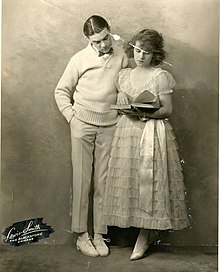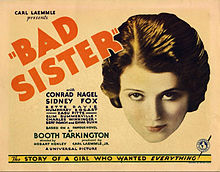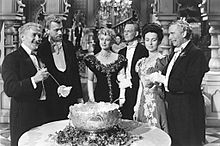Booth Tarkington
 From Wikipedia - Reading time: 18 min
From Wikipedia - Reading time: 18 min
Booth Tarkington | |
|---|---|
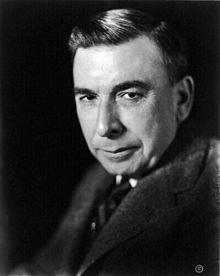 Booth Tarkington (1922) | |
| Born | Newton Booth Tarkington July 29, 1869 Indianapolis, Indiana, U.S. |
| Died | May 19, 1946 (aged 76) Indianapolis, Indiana, U.S. |
| Occupation | Novelist, dramatist |
| Education | Purdue University Princeton University |
| Years active | 1899–1946 |
| Notable works |
|
| Notable awards | Pulitzer Prize for Fiction (1919, 1922) |
| Spouse | Louisa Fletcher
(m. 1902; div. 1911)Susanah Keifer Robinson
(m. 1912) |
| Children | 1 |
| Signature | |
Newton Booth Tarkington (July 29, 1869 – May 19, 1946) was an American novelist and dramatist best known for his novels The Magnificent Ambersons (1918) and Alice Adams (1921). He is one of only four novelists to win the Pulitzer Prize for Fiction more than once, along with William Faulkner, John Updike, and Colson Whitehead. In the 1910s and 1920s he was considered the United States' greatest living author.[1] Several of his stories were adapted to film.
During the first quarter of the 20th century, Tarkington, along with Meredith Nicholson, George Ade, and James Whitcomb Riley helped to create a Golden Age of literature in Indiana.
Booth Tarkington served one term in the Indiana House of Representatives, was critical of the advent of automobiles, and set many of his stories in the Midwest. He eventually moved to Kennebunkport, Maine, where he continued his life work even as he suffered a loss of vision.[2]
He is often cited as an example of an author a great success when alive, whose reputation and influence did not survive his death.
Early life and education
[edit]Tarkington was born in Indianapolis, Indiana, on July 29, 1869,[3] the son of John S. Tarkington, a judge,[4] and Elizabeth Booth Tarkington. He came from a patrician Midwestern family that had lost much of its wealth after the Panic of 1873.[citation needed] Tarkington was named after his maternal uncle Newton Booth, then the governor of California. He was also related to Chicago Mayor James Hutchinson Woodworth through Woodworth's wife, Almyra Booth Woodworth.[citation needed]
Tarkington attended Shortridge High School in Indianapolis, and completed his secondary education at Phillips Exeter Academy, a boarding school on the East Coast.[5] He attended Purdue University for two years, where he was a member of the Sigma Chi Fraternity and the university's Morley Eating Club.
Some of his family's wealth returned after the Panic of 1873, and his mother transferred Booth from Purdue to Princeton University. At Princeton, Tarkington is said to have been known as "Tark" among the members of the Ivy Club, the first of Princeton's historic eating clubs.[6] He had also been in a short-lived eating club called "Ye Plug and Ulster," which became Colonial Club.[7][8] He was active as an actor and served as president of Princeton's Dramatic Association, which later became the Triangle Club, of which he was a founding member according to Triangle's official history.[9]
Tarkington made his first acting appearance in the club's Shakespearean spoof Katherine, one of the first three productions in the Triangle's history written and produced by students. Tarkington established the Triangle tradition, still alive today, of producing students' plays.[10] Tarkington returned to the Triangle stage as Cassius in the 1893 production of a play he co-authored, The Honorable Julius Caesar. He edited Princeton's Nassau Literary Magazine, known more recently as The Nassau Lit.[11] While an undergraduate, he socialized with Woodrow Wilson, an associate graduate member of the Ivy Club. Wilson returned to Princeton as a member of the political science faculty shortly before Tarkington departed; they maintained contact throughout Wilson's life. Tarkington failed to earn his undergraduate A.B. because of missing a single course in the classics. Nevertheless, his place within campus society was already determined, and he was voted "most popular" by the class of 1893.
Many aspects of Tarkington's Princeton years and adult life were paralleled by the later life of another writer, fellow Princetonian F. Scott Fitzgerald.[citation needed]
Career
[edit]Tarkington's first successful novel was The Gentleman from Indiana (1899).[4] In 1902–1903, he served one term as a Republican member of the Indiana House of Representatives, an experience reflected in his 1905 short story collection, In The Arena.[12]
As a novelist, Tarkington was both prolific and commercially successful. During the 15-year period from 1914 to 1928, seven of his novels ranked among the top ten best-selling books of the year: Penrod (1914), The Turmoil (#1 best seller of 1915), Seventeen (#1 best seller of 1916), Gentle Julia (1922), The Midlander (1924), The Plutocrat (1927) and Claire Ambler (1928).[13] He produced both of his Pulitzer Prize-winning novels during the same period.
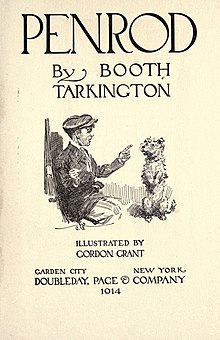
Two of his novels achieved longer-term commercial success. Penrod was one of a select group of novels that sold more than 750,000 copies during the period 1895–1975, according to Publishers Weekly book sales data from that period.[13] At one time, his Penrod series was as well known as Huckleberry Finn by Mark Twain.[citation needed] Seventeen, a coming-of-age story, sold some 1.7 million copies during the 1895–1975 period. Although written for an adult audience, it came to be regarded as a children's book and was one of the best-selling books of the era in that category.[13]
The Two Vanrevels and Mary's Neck appeared on the annual best-seller lists a total of nine times.[citation needed]
Tarkington authored 25 plays, including three collaborations with Harry Leon Wilson. Some of the plays dramatized his novels.[12] Some were eventually filmed, including Monsieur Beaucaire, Presenting Lily Mars, and The Adventures and Emotions of Edgar Pomeroy, made into a serialized film in 1920 and 1921. In 1928, he published a book of reminiscences, The World Does Move. He illustrated the books of others, including a 1933 reprint of Adventures of Huckleberry Finn, as well as his own.
Themes
[edit]Tarkington was an unabashed Midwestern regionalist and set much of his fiction in his native Indiana. His style has been compared to that of Mark Twain and William Dean Howells.[12]
Much of Tarkington's work consists of satirical and closely observed studies of the American class system and its foibles. Themes of the nouveau riche and upward social mobility appear frequently in his books.[12]
Awards and recognition
[edit]Literary
[edit]While Tarkington never earned a college degree, he was accorded many awards recognizing and honoring his skills and accomplishments as an author. He won the Pulitzer Prize for Fiction twice, in 1919 and 1922, for his novels The Magnificent Ambersons[14] and Alice Adams.[15]
Other achievements include:
- Booksellers rated him "the most significant contemporary American author" in a 1921 poll conducted by Publishers Weekly. In 1922, The Literary Digest called him America's greatest living author, and The New York Times selected him as one of the 10 greatest living Americans.[16]
- He won the O. Henry Memorial Award in 1931 for his short story "Cider of Normandy".[citation needed]
- He was awarded the National Institute of Arts and Letters Gold Medal in 1933.[citation needed]
- The Magnificent Ambersons, which Orson Welles filmed in 1942, is included in the Modern Library's list of the 100 best novels.[17]
Honorary
[edit]Tarkington's honorary degrees included an A.M. and a Litt.D. from Princeton, and honorary doctorates from Columbia University and Purdue. He made substantial donations to Purdue for building an all-men's residence hall, which the university named Tarkington Hall in his honor.[18]
Personal life
[edit]Tarkington was married to Laura Louisa Fletcher from 1902 until their divorce in 1911. Their only child, Laurel, was born in 1906 and died in 1923. Fletcher, a published poet, was involved in adapting his fiction for the stage.[19] Her prosperous Indiana banking family is thought to be the model for certain characters in Tarkington's writing.[4]
Tarkington's second marriage was to Susanah Keifer Robinson in 1912. They had no children.[20]
Tarkington began losing his eyesight in the 1920s. He continued producing his works by dictating to his secretary Elizabeth Trotter.[21] Despite his failing eyesight, between 1928 and 1940 he edited several historical novels by his Kennebunkport, Maine, neighbor Kenneth Roberts, who described Tarkington as a "co-author" of his later books and dedicated three of them (Rabble in Arms, Northwest Passage, and Oliver Wiswell) to him.
Tarkington underwent eye surgery in February 1929. In August 1930, he suffered a complete loss in his eyesight and was rushed from Maine to Baltimore for surgery on his right eye. He had an additional two operations in the latter half of 1930. In 1931, after five months of blindness, he underwent a fifth and final operation. The surgery resulted in a significant restoration in his eyesight. However, his physical energy was diminished for the remainder of his life.[22][1]
Tarkington maintained a home in his native Indiana at 4270 North Meridian Street in Indianapolis. From 1923 until his death,[5] Tarkington spent summers and then much of his later life in Kennebunkport at his much loved home, Seawood. In Kennebunkport, he was well known as a sailor, and his schooner, the Regina, survived him. Regina was moored next to Tarkington's boathouse, The Floats, which he also used as his studio. His extensively renovated studio is now the Kennebunkport Maritime Museum.[23][24] It was from his home in Maine that he and his wife Susannah established their relation with nearby Colby College.

Tarkington took a close interest in fine art and collectibles[3] and was a trustee of the John Herron Art Institute. He made a gift of some his papers to Princeton, his alma mater, and his wife Susannah, who survived him by over 20 years, made a separate gift of his remaining papers to Colby College after his death. Purdue University's library holds many of his works in its Special Collection's Indiana Collection. Indianapolis commemorates his impact on literature and the theatre, and his contributions as a Midwesterner and "son of Indiana" in its Booth Tarkington Civic Theatre.
Tarkington died on May 19, 1946, aged 76, in his home in Indianapolis. He was buried in Crown Hill Cemetery.[3]
Legacy
[edit]In the 1910s and 1920s, Tarkington was regarded as "the most important and lasting writer of his generation",[25] perhaps as important as Mark Twain. His works were reprinted many times, were often on best-seller lists, won many prizes, and were adapted into other media. Penrod and its two sequels were regular birthday presents for bookish boys.[citation needed]
By the later twentieth century, however, he was ignored in academia: no congresses, no society, no journal of Tarkington Studies.[citation needed] In 1981, The Avenue (Penguin) Companion to English and American Literature described him as "the epitome of the middle-brow American novelist."[12] In 1985, he was cited as an example of the great discrepancy possible between an author's fame when alive and oblivion later. According to this view, if an author succeeds at pleasing his or her contemporaries—and Tarkington's works have not a whiff of social criticism—he or she is not going to please later readers of inevitably different values and concerns.[26]
In 2004, author and critic Thomas Mallon noted: "Entirely absent from most current histories of American writing, Tarkington was generally scorned by those published just before or after his death."[27]
In 2019, Robert Gottlieb wrote that Tarkington "dwindled into America's most distinguished hack." Gottlieb criticized Tarkington's anti-modernist perspective, "his deeply rooted, unappeasable need to look longingly backward, an impulse that goes beyond nostalgia," for preventing him from "producing so little of real substance."[1]
Mallon wrote of Tarkington that "only general ignorance of his work has kept him from being pressed into contemporary service as a literary environmentalist—not just a 'conservationist,' in the [Theodore Roosevelt] mode, but an emerald-Green decrier of internal combustion":
The automobile, whose production was centered in Indianapolis before World War I, became the snorting, belching villain that, along with soft coal, laid waste to Tarkington's Edens. His objections to the auto were aesthetic—in The Midlander (1923) automobiles sweep away the more beautifully named "phaetons" and "surreys"—but also something far beyond that. Dreiser, his exact Indiana contemporary, might look at the Model T and see wage slaves in need of unions and sit-down strikes; Tarkington saw pollution, and a filthy tampering with human nature itself. "No one could have dreamed that our town was to be utterly destroyed," he wrote in The World Does Move. His important novels are all marked by the soul-killing effects of smoke and asphalt and speed, and even in Seventeen, Willie Baxter fantasizes about winning Miss Pratt by the rescue of precious little Flopit from an automobile's rushing wheels.[28]
In June 2019, the Library of America published Booth Tarkington: Novels & Stories, collecting The Magnificent Ambersons, Alice Adams, and In the Arena: Stories of Political Life.
Works
[edit]Trilogies
[edit]Penrod
[edit]- 1914: Penrod
- 1916: Penrod and Sam
- 1929: Penrod Jashber
Two film musicals were loosely based on the Penrod series, On Moonlight Bay (1951) and its sequel, By the Light of the Silvery Moon (1954), with Doris Day and Gordon MacRae.
Growth
[edit]- 1915: The Turmoil
- 1918: The Magnificent Ambersons
Winner of the 1919 Pulitzer Prize
Adapted for a 1942 film by Orson Welles and a 2002 television movie - 1923: The Midlander (re-titled National Avenue in 1927)
Novels
[edit]- 1899: The Gentleman from Indiana
- 1900: Monsieur Beaucaire
- Later adapted as a play, an operetta and two films: 1924 and 1946
- 1901: Old Grey Eagle
- 1903: Cherry
- Serialized in Harper's Magazine, January and February 1901
- 1902: The Two Vanrevels
- 1905: The Beautiful Lady
- 1905: The Conquest of Canaan
- 1905: In the Arena
- 1907: His Own People
- 1908: The Quest of Quesnay
- 1909: Beasley's Christmas Party
- 1912: Beauty and the Jacobin, an Interlude of the French Revolution
- 1913: The Flirt, adapted for The Flirt (1922 film)
- 1916: Seventeen
- 1916: The Spring Concert
- 1917: The Rich Man's War
- 1919: Ramsey Milholland
- 1921: Alice Adams
- Winner of the 1922 Pulitzer Prize
Adapted for film in 1923 and 1935
- Winner of the 1922 Pulitzer Prize
- 1922: Gentle Julia
- 1925: Women
- 1927: The Plutocrat
- 1928: Claire Ambler
- 1928: The World Does Move
- 1930: Mirthful Haven
- 1932: Mary's Neck
- 1933: Presenting Lily Mars
- Adapted for film in 1943
- 1934: Rumbin Galleries (romantic novel)
- 1934: Little Orvie
- 1936: Horse and Buggy Days
- Appeared in Cosmopolitan, September 1936
- 1936: The Lorenzo Bunch
- 1941: The Fighting Littles
- 1941: The Heritage of Hatcher Ide
- 1943: Kate Fennigate
- 1945: Image of Josephine
- 1947: The Show Piece (posthumously published)
Short story collections
[edit]- In the Arena: Stories of Political Life (1905)
- The Fascinating Stranger and Other Stories (1923)
Short stories
[edit]- 1919: War Stories (one of Tarkington's stories was included in this anthology)
Collections
[edit]- 1904: Poe's Run: and other poems … to which is appended the book of the chronicles of the Elis (co-author, with M'Cready Sykes)
- 1921: Harlequin and Columbine
Non-fiction
[edit]- What the Victory or Defeat of Germany Means to Every American (1917)
- Looking Forward, and Others (1926)
Contains "Looking Forward to the Great Adventure", "Nipskillions", "The Hopeful Pessimist", "Stars in the Dust-heap", "The Golden Age" and "Happiness Now" - The Collector's Whatnot (1923)
- Just Princeton (1924)
- The World Does Move (1929)
- Some Old Portraits (1939; essays on 17th century artworks)
- What We've Got to Do (1942)
- Booth Tarkington On Dogs (1944)
- Your Amiable Uncle (1949)
- On Plays, Playwrights, and Playgoers (1959)
Plays
[edit]- 1907: The Man from Home (co-written with Harry Leon Wilson)[29]
- 1908: Cameo Kirby (One-act play co-written with Harry Leon Wilson)[30]
- 1910: Your Humble Servant (co-written with Harry Leon Wilson)
- 1916: The Ohio Lady (co-written with Julian Leonard Street, and later reworked into The Country Cousin)[31][32]
- 1916: Mister Antonio[33]
- 1917: The Country Cousin (co-written with Julian Leonard Street)[34]
- 1919: The Gibson Upright (co-written with Harry Leon Wilson)
- 1919: Up from Nowhere (co-written with Harry Leon Wilson)[35]
- 1919: Clarence[36]
- 1921: The Wren[37]
- 1921: The Intimate Strangers[38]
- 1922: The Ghost Story
- 1923: The Trysting Place
- 1926: Bimbo the Pirate
- 1927: Station YYYY
- 1927: The Travellers
- 1930: How's Your Health?
- 1945: Lady Hamilton and Her Nelson (radio play, written in 1940)
References
[edit]- ^ a b c Gottlieb, Robert (November 11, 2019). "The Rise and Fall of Booth Tarkington". The New Yorker. Retrieved November 17, 2019.
- ^ "Booth Tarkington Dies". The Indianapolis Star. May 20, 1946. p. 1. Retrieved October 25, 2021 – via Newspapers.com.
- ^ a b c "Booth Tarkington Dies". The Indianapolis Star at Newspapers.com. May 20, 1946. Retrieved August 15, 2023.
- ^ a b c Indiana Authors And Their Books, 1816-1916. Crawfordsville, Indiana: Wabash College. pp. 313–314. Retrieved August 17, 2023.
- ^ a b Price, Nelson (2004). Indianapolis Then & Now. San Diego, California: Thunder Bay Press. p. 122. ISBN 1-59223-208-6.
- ^ Rothenberg, Randall (May 4, 1991). "An Old Club Breaks Bread, and a Tradition Crumbles". The New York Times.
- ^ Ringler, William (June 1, 1932). "Princeton Authors at the Turn of the Century". Nassau Literary Review.
- ^ Bric a Brac Yearbook, Princeton University, 1892, listed as "N. B. Tarkington."
- ^ "The Triangle Club, Princeton University". Retrieved October 4, 2014.
- ^ "Triangleshow". Retrieved October 4, 2014.
- ^ "Nassau Lit, The". Etcweb.princeton.edu. Archived from the original on April 18, 2012. Retrieved July 23, 2012.
- ^ a b c d e The Avenel Companion to English and American Literature, ed. David Daiches, Malcom Bradbury and Eric Mottram. Avenel Books/Penguin Books Ltd. 1981. p. 246 (American section).
- ^ a b c Hackett, Alice Payne and Burke, James Henry (1977). 80 Years of Best Sellers: 1895 - 1975. New York: R.R. Bowker Company. pp. 80–105. ISBN 0-8352-0908-3.
{{cite book}}: CS1 maint: multiple names: authors list (link) - ^ "1919 Pulitzer Prize Winners and Finalists (Novel)". The Pulitzer Prizes.
- ^ "1922 Pulitzer Prize Winners & Finalists". The Pulitzer Prizes. Retrieved August 15, 2023.
- ^ Beer, Jeremy. "The Magnificent Tarkington". The Claremont Review of Books. The Claremont Institute. Retrieved August 15, 2023.
- ^ "The 100 Best Novels". The Modern Library. Penguin Random House. Retrieved August 16, 2023.
- ^ "Tarkington Hall". Purdue University. April 15, 2009. Archived from the original on April 15, 2009. Retrieved July 23, 2012.
- ^ "Mrs.Laurel Connelly, 78; Booth Tarkington's First Wife, A Poet, is Dead". Times Machine: February 8, 1957. The New York Times. Retrieved August 17, 2023.
- ^ "Booth Tarkington - Biography and Works. Search Texts, Read Online. Discuss". Online-literature.com. January 26, 2007. Retrieved July 23, 2012.
- ^ "Booth Tarkington dictating a story to Elizabeth Trotter, 1938". Maine Memory Network. Retrieved January 8, 2023.
- ^ Booth Tarkington (June 4, 2019). Booth Tarkington: Novels & Stories (LOA #319): The Magnificent Ambersons / Alice Adams / In the Arena: Stories of Political Life. Library of America. p. 708. ISBN 978-1-59853-621-8.
- ^ "Booth Tarkenton: Collection Overview and Biographical Note". Colby College Libraries. Colby College. Retrieved August 17, 2023.
- ^ "Kennebunkport Maritime Museum/Gallery Kennebunkport Maine". Ohwy.com. Retrieved July 23, 2012.
- ^ Woodress, James (November 12, 2023). "The Tarkington Papers". The Princeton University Library Chronicle. XVI (Winter 1955 Number 2): 45–53. doi:10.2307/26402872. JSTOR 26402872. Retrieved August 20, 2023.
- ^ Eisenberg, Daniel (1985). A Study of "Don Quixote". Juan de la Cuesta. p. 178. ISBN 0936388315.
- ^ Mallon, Thomas (May 2004). "Hoosiers: The Lost World of Booth Tarkington. May 2004". The Atlantic. Retrieved August 17, 2023.
- ^ Mallon, Thomas (May 2004). "Hoosiers: The Lost World of Booth Tarkington". The Atlantic. Archived from the original on May 22, 2010. Retrieved December 30, 2013 – via Wayback Machine.
- ^ "News of the Theaters". Chicago Tribune. Chicago, Illinois. September 30, 1907. p. 8 – via Newspapers.com.
- ^ "George Tyler Home With a Lame Foot". The New York Times. New York, New York. August 5, 1908. p. 5 – via NYTimes.com.
- ^ Sayler, Oliver M. (January 25, 1916). "The Man From Home in Skirts". The Indianapolis News. Indianapolis, Indiana. p. 8 – via Newspapers.com.
- ^ Kaufman, George S. (July 22, 1917). "The Coming Crop of Plays". New-York Tribune. New York, New York. p. 29 – via Newspapers.com.
- ^ "A Tarkington Play with Otis Skinner". The New York Times. New York, New York. September 19, 1916. p. 9 – via NYTimes.com.
- ^ "Civil War in 'The Country Cousin'". The New York Times. New York, New York. September 4, 1917. p. 9 – via NYTimes.com.
- ^ White Jr., Matthew (December, 1919). "The Stage". Munsey's Magazine. Vol. LXVIII, No. 3. p. 526. Retrieved September 23, 2024.
- ^ Woollcott, Alexander (September 22, 1919). "The Play". The New York Times. New York, New York. p. 8 – via NYTimes.com.
- ^ Woollcott, Alexander (October 11, 1921). "The New Play". The New York Times. New York, New York. p. 22 – via NYTimes.com.
- ^ Woollcott, Alexander (November 8, 1921). "The New Play". The New York Times. New York, New York. p. 28 – via NYTimes.com.
External links
[edit]- Booth Tarkington at IMDb
- Booth Tarkington at the Internet Broadway Database
- Booth Tarkington at the Internet Off-Broadway Database
- PoliticalGraveyard.com entry
- Biography from Colby College collection of his papers
- Booth Tarkington at Fantastic Fiction
- The Judy Room "Presenting Lily Mars" Section.
- Booth Tarkington Civic Theatre
- Booth Tarkington at Library of Congress, with 216 library catalog records
- Finding aid to Booth Tarkington papers at Columbia University. Rare Book & Manuscript Library.
- Booth Tarkington Collection at the Harry Ransom Center
Online editions
[edit]- Works by Booth Tarkington in eBook form at Standard Ebooks
- Works by Booth Tarkington at Project Gutenberg
- Works by Booth Tarkington at Faded Page (Canada)
- Works by or about Booth Tarkington at the Internet Archive
- Works by Booth Tarkington at LibriVox (public domain audiobooks)

 KSF
KSF
